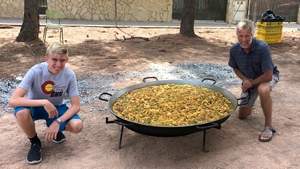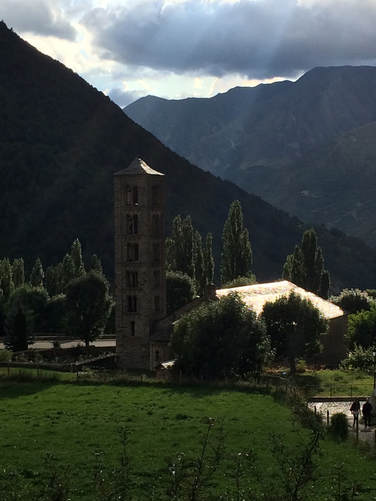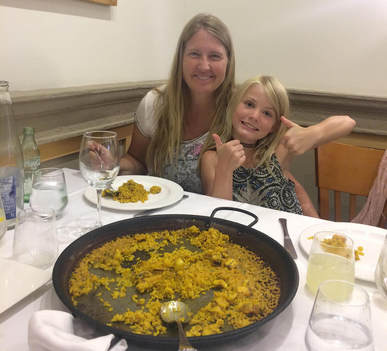 Paella is the main dish of Valencia. Even though it is served elsewhere in Spain, it originated here. The rice produced in Valencia is a wonderful short-grain rice that is flavorful and creamy. When making paella, the key is to have the rice become crusty on the bottom and soft on top. Although cooking in Spain is squarely in the woman’s domain, paella is a manly dish. It could be considered a contact sport for cooking. Men are very competitive about their paella. It is somewhat akin to barbecuing in the United States. To be true paella, it must be cooked over a fire. And I have heard women talking about rice dishes that look exactly like paella, but they say are not paella because the cook added pepper. Traditional paella includes chicken, rabbit, snails, flat beans and large butter beans. Mike, my husband, hikes on Saturdays with a Spanish man he met named Hector. Hector is working on his English and has also taken it upon himself to become our adviser in all things Spanish. After hiking with Mike and getting a bocadilla and beer for the traditional “almuerza,” Hector goes home to make paella for his girlfriend on Saturdays. He has been coaching Mike on the art of paella and was appalled that Mike had been cooking it in the oven in a non-paella pan. So Mike bought a paella pan and proudly had Hector over to see it. Hector grimaced and said, “Oh, Mike, I sorry to tell you that you no buy good pan. This not true paella pan.” Needless to say, this has been the source of endless joking by our teenage son. As part of its annual fundraiser, the American School of Valencia holds a paella contest. It is set up in an open field with fire pits spread around. Groups of men sweat and tend the fires, nervously eyeing each others’ progress. There is a great rivalry that borders on true anger between a group of Spanish men and an Irishman who has lived in Spain for many years. The contest winner is chosen through a blind taste test and the Irishman has won for the past two years. There is much grumbling that an Irishman should never beat a Spaniard when it comes to making paella. This year, there was also a group of college-aged boys that entered. It was their first year, and they received much ribbing from the older men, especially because they didn’t finish boiling down their rice by the time the contest ended. As a result, they were forced to enter a soupy concoction. Paella is so popular that there is also the fast-food version served everywhere (looked down on by true paella connoisseurs). It is strange to stop in gas stations and see a big pan of paella, go to an amusement park and see paella stands or drive by “paella to go” fast-food restaurants. Here’s the truth, though. I am absolutely sick of paella. I can hardly look at it now. It is another example of something that seemed exotic when we moved here and now has become common. I feel that after living in Spain for four months, I can actually criticize it without guilt. When you go to the “carneria” and order a chicken or rabbit for paella, they cut it a certain way. They pull out the meat and cut it up with a cleaver right in front of you. However, they don’t cut it as we are used to into white and dark meat. They basically just chop the whole chicken into pieces of a certain size. So you may pull out a piece of chicken that only consists of a rib or a spine with no meat on it at all. This grosses my son out so much that Mike has started buying separate chicken breasts, even though we have accepted that it means we are not eating pure paella. The other thing that is interesting to me is how many Spaniards order paella at restaurants. Paella is actually very bland and after the first few tries. It seems more like eating your mom’s pot roast every Sunday or meatloaf on Saturdays – comfort food you have once a week at home but would never order in a restaurant. Yet, people here can’t get enough of it. Mike continued to order it at restaurants long after the rest of us had moved on until, two weeks ago, he pulled a rabbit skull, complete with teeth, out of his paella dish. This was too much even for him. So our paella sampling is on hold for a little while, except as a weekly Sunday lunch cooked by Mike with unauthentic chicken cuts in our sub-par pan.
0 Comments
 As I sit at a café writing this column, I listen to groups of women around me talking. At 10 a.m., women come together to smoke, drink coffee and talk about their lives. Their gestures are animated and their words are fast and loud, often overlapping each other. As I strain to comprehend the conversations around me, it is a stark reminder of how difficult it actually is to speak and understand another language. Up until coming to Spain, I’ve been learning Spanish through the popular online language program, Duolingo. As of now, it says I am 50 percent fluent in Spanish, but it is one thing to be able to speak online as opposed to speaking with real people. They do not say their words one at a time or even follow the rules that the program teaches. Plus, in Spain there are so many different colloquialisms and pronunciations that nothing sounds the same. When you factor in that most people also speak Valencian, which is very similar to Spanish, you can never be sure of what you are hearing. My son, who has been taking Spanish at school for five years, basically feels he is starting from scratch. The kids have a steep learning curve because all of the kids slip into Spanish, and Spanish slang, whenever they aren’t in class, so to have friends, they have to start picking it up fast. My husband and I just started Spanish lessons in Puzol with a Valencian woman who offers small group classes. We are in class with three people from Poland and two from Holland. It is humbling to realize that they are learning at least their second language and in some cases their third. Much of the class is taken up with analyzing the differences between cultures and words, which is fascinating. One of the most useful things about the class so far has been getting answers to questions about words and phrases that people say regularly. One of the girls at school told Celia she was a “mono,” which means monkey in Spanish. It turns out that people in Spain use the word “mono” to mean “very cute.” So, Celia was relieved to know that she was getting a compliment, not an insult. We also now know that people in Spain shorten “Hasta luego” to “Lugo.” This now explains what many people say to us in passing. The most widely used word in Spain is definitely “vale.” Up until we got here, we hadn’t even heard it because it is used in Spain, not Central America. You can’t find it on Google Translate (our life raft in Spain). It basically means “OK” or “Got it,” but people tend to use it in every sentence. Between “vale” and “que” you can usually respond to whatever people say. Even though it seems daunting to become bilingual, and I am frustrated each day by my lack of integration because of my shortcomings, I have to remind myself that it is coming along. As I listen to the women beside me or the radio station or commentary during soccer games, I realize that I can now pick out most of the words. It doesn’t just come across as sounds. If I memorize what someone has just said, I can also translate it later at a very slow pace. My brain just can’t keep up with the speed. People say that you realize you know a language when you no longer have to translate it in your head. Speaking is another embarrassment. I am usually proud when I put a sentence together with actual verbs and nouns, not just one word and pointing. But the better I get at speaking, the more people think I can actually understand it, too. I guess it is an accomplishment when people respond. That means that I pronounced the words well enough for someone to understand me. But this comes with the downside that they actually respond to me in Spanish, at which point I have a blank stare on my face. It is then that I usually respond with “Vale” or “Que?” – the failsafe Spanish response.  August is essentially vacation time in Spain. Many of the shops and restaurants in Puzol have signs on them saying “closed for vacation – back in September.” So, we decided to join the throngs of vacationers and do a loop through Costa Brava and the Pyrenees before the weather got too cold. The high point on our journey was the Parc Nacional d’Aiguestortes i Estany de Sant Maurici in the Catalan Pyrenees and the village of Taull. The first thing I thought when entering Taull was that this village looks like what a village in the Pyrenees should look like. I was reminded that visitors go to Epcot Center at Disney World to feel like they are actually in another country. The caricatures there represent the stereotypes that people envision, even if the real thing isn’t really like the expectation. All I can say is that Taull feels like a caricature of itself and is better than the expectation. As a Coloradan who is used to mountains, I was still awed by the Pyrenees. What is amazing to me is how Europeans have perfected the art of compact living and blending into the scenery. Rather than sprawling towns built in valleys between mountains, as in the United States, towns in the Pyrenees are built at the top of a peak but so compact that green can be seen for miles, as well as other small dots of towns. It feels as if you are part of the natural beauty around you. This, coupled with the many stone chapels and monasteries, gives the villages the feel of growing from the Earth itself. Hiking in the park is controlled to limit visitors and traffic. We were four of eight people being taken to our trailhead. Our destination was Estany Long (Long Lake), and a rainstorm came in just as we were departing, which added to the ambiance. Clouds and mist hung below the peaks and through the valleys. The park interpreter sold us raincoats and loaned us his umbrella from his small cabin at the trailhead. The land itself is breathtaking, with open glacial valleys, high peaks, carved lakes and cold streams. Another of the amazing things throughout this area are the Byzantine churches that are in the little towns. Combined, all nine of them constitute a Unesco World Heritage Site, and each shows painted walls that combine Romanesque Christian images with animals and mythology. Their ancient stone beauty adds to the romance of the area. Each church has its own bell tower that can be climbed on steep stairs. From each one was a unique and awe inspiring view of the mountains, the spotted villages and the blue clear skies. The air itself smelled fresh and musty at the same time. In this high mountain air, the surreal is mixed with the picturesque. On our taxi ride back from our trailhead, we passed a mountain lake where two women were about to swim. Our driver angrily pulled over to tell them that they couldn’t swim there, and they proceeded to get into a heated argument. Another taxi van pulled up and the driver jumped into the argument. The strange thing was that the women were entirely naked. They stood and argued with everyone as if it were no big deal. This encounter is yet another reminder that this is not the Epcot Center. It is the people, and not just the sites, that make up the amazing experience of living in Spain. Sally Shuffield is a Durango resident living in Spain for a year with her family. Follow her blog at www.sallyshuffield.net/spain-blog.  For a variety of reasons, our family decided to move to Spain for a year. We uprooted our Durango teenager and grade schooler, left our jobs, found a friend to take our dog and packed up our house. It is an amazing experience and our hope is we will come back bilingual and with a better understanding of more of the world. Even though we hope to incorporate some traveling, it’s not a vacation. It’s the little things that make you realize you’re in a new country on a new continent. These things aren’t expected because they are things you don’t notice until you try to act as if nothing is different. Just like learning language, we all grow up learning how to function in our world. So, in addition to learning how to speak in a new country, it takes time to learn how to act, as well. For the next year, this column will focus mainly on what it is like to actually live in a new culture. First things first: the food. People tell you about the amazing food in Spain. So far, I have found that to be true, but it also depends on what you like to eat. If you are a breakfast lover, you are out of luck. The American fare of eggs, pancakes, burritos, etc. cannot be found. However, if you are a fan of big, filling lunches with lots of rice, seafood and ham, you are in luck. I feel like every meal is like going to a fine restaurant for cheap. There are no burgers and club sandwiches on the menu. Choices at even the quicker restaurants include a variety of fishes, rices, rabbit, pork, lobster, roast suckling pig and octopus, all in fairly large portions. One meal around 3 p.m. each day provides the majority of your calories (well, healthy calories – the beer and chocolate croissants for breakfast are another matter). Obviously, living somewhere precludes the option of eating out every meal like you would on a vacation. So, the struggle is to feel like you are in Spain in your own home during meals. We have enthusiastically embraced the coffee and chocolate croissant for breakfast, as well as the jamon and cheese baguette for the mid-morning snack. Tapas at 11 p.m. are only for special occasions on the town when you have kids, so we’ve been having melon, bread, olives and cheeses for tapas around 8 p.m. This leaves the main mid-day meal. We have cut back on beef, fallen in love with a specialty jamon pizza and tried to incorporate rice dishes and seafood. The big obstacle to cooking like a Spaniard is getting foods from the market to your table. You really need to grow up cooking in Spain or have a strong affinity to learn (luckily, Mike, my husband, does). Ham, the meat of choice here, is bought in large slabs, all shrimp have their heads, muscles have their beards and fish can be presented with their tongues hanging out. Legumes must be soaked, broths must be made for rices, and rubbery squids must be chopped and marinated. The mid-day meal doesn’t just take a long time to eat, it takes a long time to prepare. Embracing life in a new country requires letting go of old cravings and habits. Spain makes this easy by not even offering familiar options. It’s actually nice not to be catered to as Americans. You either figure it out, go broke or go hungry. Sally Shuffield is a Durango resident living in Spain for a year with her family. Follow her blog at www.sallyshuffield.net/spain-blog. |
contact
|





